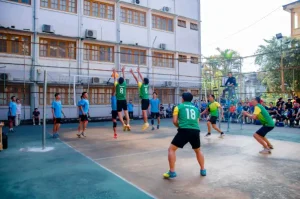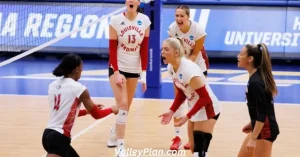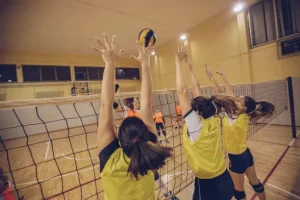Rotational defense is a strategic system employed by volleyball teams to cover the court and counteract the opponent’s attacks effectively.
Unlike other defensive formations, rotational defense involves players moving and shifting positions based on the location of the opposing team’s hitters.
The primary objective is to create a solid defensive block and ensure that every area of the court is covered.
Rotational Defense in Volleyball: A Player’s Guide
Volleyball, a sport known for its dynamic plays and strategic moves, requires teams to master various defensive techniques to secure victory. Turnover defense is an essential defensive technique that is used all the time in the game.
This article will explain the basics of circular defense, why it’s necessary to keep a solid defensive structure, and how players can use this strategy on the court.

Basics of Rotational Defense In Volleyball
| Basics of rotational defense | Description |
|---|---|
| Player Movement | Players in rotational defense constantly adjust their positions as the opponent transitions from one rotation to another. This movement is synchronized to create a seamless defensive structure. |
| Court Coverage | It is essential to cover the whole floor so that the other team has a hard time finding open spots to attack. The players work together to make a strong defense. |
| Adaptability | Being able to change quickly is essential for rotational defense. Consequently, players must scan the opponent’s plays and adjust their positions to block or dig the ball effectively. |
Difference Between Rotational And Perimeter Defense
| Aspects | Rotational Defense | Perimeter Defense |
|---|---|---|
| Flexibility | Dynamic and adaptable to different opponent plays. | More rigid, with players assigned specific zones. |
| Emphasis | Focus on player movement and adaptability. | Focus on court coverage within assigned areas. |
| Player Roles | Players may have more diverse roles and responsibilities. | Players have specific roles based on court positions. |
| Communication | Requires constant communication for effective shifts. | Communication is crucial for coordinated court coverage. |

Implementation of Rotational Defense
Communication is Key
A successful rotational defense scheme requires good communication. Additionally, players must communicate constantly to track the ball, identify threats, and organize defenses.
Furthermore, clear communication keeps things simple and ensures every player knows their role in each rotation.
Quick Transitions
Rotational defense demands swift transitions between rotations. Players need to move seamlessly from one defensive position to another, maintaining a well-organized formation.
Quick changes prevent gaps in the defense and help players respond promptly to the opponent’s attacks.
Reading the Opponent
Reading the other team’s plays is an integral part of circular defense. To play well, players must look at the other team’s shape, guess how they will attack, and then move to match.
Reading the opponent’s movements allows players to pre-position themselves for effective blocks and digs.

Significance of Rotational Defense
Blocking Efficiency
Rotational defense enhances a team’s blocking efficiency by ensuring that blockers are well-positioned to block the opponent’s spikes.
Additionally, the constant movement and adaptability of rotational protection make it challenging for hitters to predict and exploit gaps in the block.
Court Coverage
One of the primary advantages of rotational defense is comprehensive court coverage. Additionally, by shifting positions based on the opponent’s rotation, players can cover a larger court area, reducing the chances of the ball landing in open spaces.
Consequently, this extensive court coverage adds a layer of complexity to the opponent’s offensive strategies.
Team Unity
Rotational defense fosters a sense of unity among team members. Additionally, the constant communication, synchronized movements, and shared responsibility for court coverage create a cohesive defensive unit.
This unity strengthens the defense and contributes to the overall team chemistry.
Tips for Excelling in Rotational Defense
| Tips | Description |
|---|---|
| Practice Position Transitions | Conduct drills that focus on quick position transitions during rotational changes. Emphasize the importance of maintaining proper spacing and alignment within the defensive formation. |
| Communication Drills | Devote practice time to communication drills. Develop a set of clear and concise signals or verbal cues that players can use to convey specific information during rotations. |
| Read and React Exercises | Incorporate exercises that enhance players’ ability to read the opponent’s plays. Additionally, these exercises should simulate game scenarios, allowing players to practice quick decision-making based on the opponent’s movements. |
| Emphasize Adaptability | Instill a mindset of adaptability in players. Additionally, help them understand that flexibility in positioning and a willingness to adjust to the dynamics of each rally are crucial components of successful rotational defense. |

FAQs
In volleyball, a swing defense is employed to defend against strong attacks by moving deeper into the court. Consequently, this provides players with more time to respond and maintain control of the ball. Ultimately, the goal of this strategy is to establish a robust defense against powerful hitters.
In volleyball, perimeter defense is a method employed to defend, where players strategically position themselves around the outside of the court to cover potential attack options. Consequently, this formation creates a robust wall that the opposing team can utilize to block or dig incoming shots.
To improve your volleyball defense, work on your footwork so you can move quickly, keep your stance low to be more agile, and learn to read your opponents’ body language to know when to hit. These skills will get better with regular practice and drills.
In volleyball, a 42 rotation is a unique way of placing players. Positioned in six spots numbered 1 through 6, players move clockwise after winning a rally. Consequently, as each player transitions to the next spot, skills and responsibilities are spread out evenly on the court.
In volleyball, a “32” typically refers to a specific play where the setter sets the ball for the middle hitter who attacks from the second zone, aiming to confuse the opposing blockers.
Conclusion
In conclusion, mastering rotational defense in volleyball is about more than just shifting positions on the court. It’s about effective communication, quick transitions, and the ability to read and adapt to the opponent’s strategies.
A well-executed rotating defense improves a team’s defensive ability and also helps players bond and work together. The best way to succeed in rotational protection is to work together, stay in constant communication, and strive to improve as a unit.
Your defensive prowess on the volleyball court will skyrocket if you remember these tips.
Related Posts
Volleyball Conditioning Drills

Hassan Baig a former volleyball player, coach and Administrative At Volleyplan.com.
My name is Hassan Baig and I am a former volleyball player and coach. I have a passion for the sport and have dedicated my life to promoting it. I have worked with some of the best players in the game and have helped them achieve their full potential Read More









